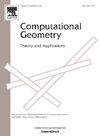Approximating Gromov-Hausdorff distance in Euclidean space
IF 0.7
4区 计算机科学
Q4 MATHEMATICS
Computational Geometry-Theory and Applications
Pub Date : 2023-06-24
DOI:10.1016/j.comgeo.2023.102034
引用次数: 10
Abstract
The Gromov-Hausdorff distance proves to be a useful distance measure between shapes. In order to approximate for , we look into its relationship with , the infimum Hausdorff distance under Euclidean isometries. As already known for dimension , cannot be bounded above by a constant factor times . For , however, we prove that . We also show that the bound is tight. In effect, for with at most n points, this gives rise to an -time algorithm to approximate with an approximation factor of .
欧氏空间中Gromov-Hausdorff距离的逼近
Gromov-Hausdorff距离(dGH)被证明是一个有用的形状之间的距离度量。为了近似X,Y⊂Rd的dGH,我们研究了它与欧氏等距下的下确界Hausdorff距离dH,iso的关系。正如已经知道的,对于维数d≥2,dH,iso不能在上面由常数因子乘以dGH来定界。然而,对于d=1,我们证明了dH,iso≤54dGH。我们还证明了界限是紧密的。实际上,对于最多有n个点的X,Y⊂R,这会产生O(nlogn) -时间算法,以近似因子(1+14)近似dGH(X,Y)。
本文章由计算机程序翻译,如有差异,请以英文原文为准。
求助全文
约1分钟内获得全文
求助全文
来源期刊
CiteScore
1.60
自引率
16.70%
发文量
43
审稿时长
>12 weeks
期刊介绍:
Computational Geometry is a forum for research in theoretical and applied aspects of computational geometry. The journal publishes fundamental research in all areas of the subject, as well as disseminating information on the applications, techniques, and use of computational geometry. Computational Geometry publishes articles on the design and analysis of geometric algorithms. All aspects of computational geometry are covered, including the numerical, graph theoretical and combinatorial aspects. Also welcomed are computational geometry solutions to fundamental problems arising in computer graphics, pattern recognition, robotics, image processing, CAD-CAM, VLSI design and geographical information systems.
Computational Geometry features a special section containing open problems and concise reports on implementations of computational geometry tools.

 求助内容:
求助内容: 应助结果提醒方式:
应助结果提醒方式:


